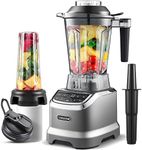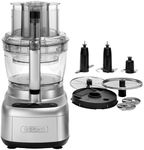Buying Guide for the Best The Food Processor
Choosing the right food processor can greatly enhance your cooking experience by saving time and effort in the kitchen. A food processor is a versatile appliance that can chop, slice, shred, grind, and puree various ingredients, making it an essential tool for both amateur cooks and professional chefs. When selecting a food processor, it's important to consider your cooking habits, the types of dishes you frequently prepare, and the amount of food you typically process. Understanding the key specifications will help you make an informed decision that best suits your culinary needs.CapacityCapacity refers to the size of the food processor's bowl, which determines how much food you can process at one time. This is important because it affects how efficiently you can prepare meals. Food processors generally come in small (up to 4 cups), medium (5-9 cups), and large (10 cups or more) capacities. If you often cook for a large family or enjoy batch cooking, a larger capacity might be more suitable. Conversely, if you typically prepare meals for one or two people, a smaller capacity could be more practical and easier to store.
PowerPower is measured in watts and indicates the motor strength of the food processor. A more powerful motor can handle tougher tasks like kneading dough or chopping hard vegetables with ease. Food processors usually range from 250 watts to over 1000 watts. For basic tasks like chopping and slicing, a lower wattage may suffice. However, if you plan to use your food processor for more demanding tasks, such as making nut butter or dough, opting for a higher wattage will ensure better performance and longevity.
Attachments and AccessoriesAttachments and accessories expand the functionality of a food processor, allowing it to perform a variety of tasks. Common attachments include slicing discs, shredding discs, dough blades, and chopping blades. Some models also offer additional accessories like citrus juicers or spiralizers. Consider what tasks you frequently perform in the kitchen and choose a food processor with the appropriate attachments. If you enjoy experimenting with different recipes, a model with a wide range of accessories might be beneficial.
Speed SettingsSpeed settings determine how fast the blades rotate, affecting the texture and consistency of the processed food. Most food processors come with at least two speed settings: low and high. Some models offer additional speed options or pulse functions for more precise control. If you often prepare a variety of dishes that require different textures, a food processor with multiple speed settings can provide greater versatility. For basic chopping and slicing, a simple two-speed model may be sufficient.
Ease of CleaningEase of cleaning is an important consideration, as food processors can have multiple parts that need to be washed after use. Look for models with dishwasher-safe components to simplify the cleaning process. Additionally, consider the design of the food processor; models with fewer crevices and smooth surfaces are generally easier to clean. If you plan to use your food processor frequently, choosing one that is easy to clean will save you time and effort in the long run.
Size and StorageThe size and storage of a food processor are important factors, especially if you have limited kitchen space. Larger models may offer more features and capacity but can be bulky and difficult to store. Consider the available space in your kitchen and whether you have room to keep the food processor on the countertop or if it needs to be stored in a cabinet. If space is a concern, look for a compact model that still meets your processing needs.

















